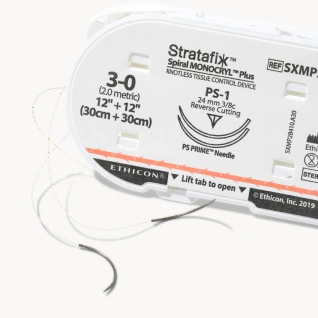Key Messages
- STRATAFIX™ Spiral MONOCRYL™ Plus is paired with premium Ethicon needles that are resistant to bending or breaking and penetrate tissue smoothly.1
- Provides smooth tissue passage and a secure hold that helps control tension and achieve excellent tissue approximation without the need to tie knots.2-9
- Saves time and eliminates knot-related complications such as an increased risk of infection from bacterial attachment.
- Incorporates antibacterial technology with triclosan coating, which has been shown to inhibit bacterial colonization of the suture for 11 days or more.10*
- Aligns with recommendations by the CDC, ACS/Surgical Infection Society, and NICE guidelines, which all advise that triclosan-coated sutures should be used to reduce the risk of SSIs.1-15†‡
- A meta-analysis of 21 randomized controlled trials showed a 28% reduction in SSI risk with the use of triclosan-coated sutures.16 ‡§
Detailed Talk Track
References
*Staphylococcus aureus, Staphylococcus epidermidis, Methicillin-resistant
†CDC, WHO, ACS/SIS, NICE, and KRINKO guidelines on reducing the risk of surgical site infections are general to triclosan-coated sutures and are not specific to any one brand.
‡All triclosan-coated sutures in these RCTs were Ethicon Plus Antibacterial Sutures (MONOCRYL™ Plus, VICRYL™ Plus, and PDS™ Plus).
§In a meta-analysis of 21 RCTs, 6462 patients, 95% CI: (14, 40%), P<0.001
1. Ethicon Wound Closure Manual 2012. Ethicon, Inc.
2. Moran ME, Marsh C, Perrotti M. Bidirectional-barbed sutured knotless running anastomosis v classic Van Velthoven suturing in a model system. J Endourol. 2007;21(10):1175-1178.
3. Vakil JJ, O’Reilly MP, Sutter EG, Mears SC, Belkoff SM, Khanuja HS. Knee arthrotomy repair with a continuous barbed suture: a biomechanical study. J Arthroplasty. 2011;26(5):710-713.
4. Eickmann T, Quane E. Total knee arthroplasty closure with barbed sutures. J Knee Surg. 2010;23(3):163-167.
5. Einarsson JI, Chavan NR, Suzuki Y, Jonsdottir G, Vellinga TT, Greenberg JA. Use of bidirectional barbed suture in laparoscopic myomectomy: evaluation of perioperative outcomes, safety, and efficacy. J Minim Invasive Gynecol. 2011;18(1):92-95.
6. Levine BR, Ting N, Della Valle CJ. Use of a barbed suture in the closure of hip and knee arthroplasty wounds. Orthopedics. 2011;34(9):e473-e475. doi: 10.3928_01477447-20110714-35.
7. 100326296: Time Zero Tissue Holding – Competitive Claims Comparisons for STRATAFIX Knotless Tissue Control Devices vs Various Products. 2015. Ethicon, Inc.
8. Ethicon study AST-2012-0331. Tissue gapping under tension of porcine cadaveric skin incisions closed with Stratafix Spiral in comparison to Monocryl in both interrupted and continuous stitching patterns. Approved on August 24, 2012. Ethicon, Inc.
9. Nawrocki J. Technical memo: Explanation on the science behind the anchors on knotless tissue control devices. 2017. Ethicon, Inc.
10. Bhende S, Burkley D, Nawrocki J. In vivo and in vitro antibacterial efficacy of absorbable barbed poydioxanone monofilament tissue control device with triclosan. Surg Infect 2018; Volume 19 (4):430-437.
11. Berríos-Torres SI, Umscheid CA, Bratzler DW, et al. Centers for Disease Control and Prevention Guideline for the Prevention of Surgical Site Infection. JAMA Surg. 2017;152(8):784_791.
doi:10.1001_jamasurg. 2017.0904.
12. World Health Organization. Global Guidelines for the Prevention of Surgical Site Infection. https:__apps.who.int_iris_bitstream_handle_10665_250680_9789241549882-eng.pdf?sequence=8. Published November 2016. Accessed August 24, 2023
13. Ban KA, Minei JP, Laronga C, et al. American College of Surgeons and Surgical Infection Society:
Surgical Site Infection Guidelines, 2016 Update. J Am Coll Surg. 2016;224(1):59_74.
14. National Institute for Health and Care Excellence (NICE) Guideline. Surgical site infections: prevention
and treatment. NICE website. https:__www.nice.org.uk_guidance_ng12 _chapter_Recommendations#closuremethods. Accessed August 24, 2023.
15. Prevention of postoperative wound infections. Recommendation of the Committee for Hospital Hygiene and Infection Prevention (KRINKO) at the Robert Koch Institute. Bundesgesundheitsbl. 2018; 61(4):448_473
16. de Jonge SW, Atema JJ, Solomkin JS, Boermeester MA. Meta-analysis and trial sequential analysis of triclosan-coated sutures for the prevention of surgical site infection. Brit J Surg. 2017;ePub-DOI: 10.1002_bjs.10445.
CONFIDENTIAL. FOR INTERNAL USE ONLY. NOT FOR USE WITH ANY CUSTOMER OR FOR EXTERNAL DISTRIBUTION.
